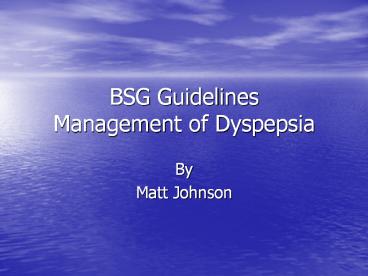BSG Guidelines Management of Dyspepsia PowerPoint PPT Presentation
Title: BSG Guidelines Management of Dyspepsia
1
BSG Guidelines Management of Dyspepsia
- By
- Matt Johnson
2
Recommendation Grading
- A gt1 meta-analysis, systematic review or body of
evidence from RCTs - B high quality case control or cohort studies, or
extrapolated from a meta-analysis, systematic
review or RCTs - C lesser case control or cohort studies
- D expert opinion or case series / reports
3
Dyspepsia Introduction
- Dyspepsia is not a diagnosis but a collection of
symptoms including upper abdo discomfort,
heartburn, retrosternal pain, anorexia, nausea,
vomiting, bloating, fullness and early satiety - Prevalence in the Western societies is quoted at
being between 23 41 - 4 of GP consultations are for dyspepsia
- 10 of these are referred to hospital
- 2 of entire adult population receive either an
OGD or a barium meal each year
4
Causes of Dyspepsia
- Normal 30
- Gastritis, Duodenitis, HH 30
- GORD 10-17
- DU 10-15
- GU 5-10
- Oesophageal, Gastric Ca 2
5
Rationalisation of Endoscopy
- Patients with dyspepsia in whom endoscopy is
inappropriate - Those lt 55y with uncomplicated dyspepsia
- Patients with known DU who have responded
appropriately to medication - Those who have recently had an OGD for the same
symptoms - Test and treat has replaced the test and
scope strategy in patients lt55y A - Pros approporiate for PU, reduction of
relapse, may benefit H.pylori
associated non-ulcer dyspepsia, potential
reduction in Cancer risk - Cons increases antibiotic exposure, may miss
significant GORD and Barretts oesophagus
(although therapy here should be directed at
symptom control as treatment directed at healing
does not prevent the known complications)
6
H.Pylori Ix
- Serology A
- Simple, useful, less specific than other methods
- Instant / near tests are less accurate and not
recommended - 13C Urea Breath Test B
- 13C or 14C cleaved by the H.pylori urease and
then monitored in the exhaled breath - Best test for identification
- Best test to ensure eradication
- Endoscopic Clo Test B
- Cheap, accurate but endoscopy not always
necessary - Recommended in all patients with newly found PU
- Faecal Ag Tests
- ?
7
Rationing of Endoscopy
- Death from diagnostic OGD 1 in 2-10,000
- The incidence of gastric Ca is age related
- OGD is recommended in all patients gt55y D
- with new onset uncomplicated dyspepsia
- for gt 1/12 duration
- Most patients with gastric cancer have alarm
symptoms - OGD is recommended in all patients with alarm
symptoms C - National Cancer Guidelines request Ix within 2/52
- These include dyspeptic patients with
- Unintentional weight loss
- GI Bleeding
- Previous gastric surgery
- Epigastric mass
- Previous gastric ulcer
- Unexplained Fe deficiency
- Dysphagia or Odynophagia
- Persistent continous vomiting
- Suspicious barium meal
8
Treatments
- Pre Endoscopy
- lt55y Test and treat
- gt55y Pre-treatment with anti-secretory drugs
may mask significant diagnosis D therefore BSG
recommend witholding or stopping pre-treatment
4/52 before OGD - Oesophagitis
- Lifestyle advice
- weight loss, propping up head end of bed
- Medication
- Symptom relief
- 4/52 course of PPIs recommended by NICE D
- Follow-up
- ? Long term management of Barretts
- Repeat OGD only recommended to review
- Healing of oesophageal ulcers
- Dilatation of strictures
- Anaemia secondary to GORD
9
Treatments
- Functional Dyspepsia
- Lifestyle advice
- little benefit (stop smoking) D
- Medication
- Recommends H.pylori eradication D
- Cochrane review May 2000 showed resolution of
symptoms in 9 after H.pylori eradication therapy - Symptomatic control with anti-secretory agents is
recommended especially in ulcer like or reflux
like symptoms B - Stop NSAIDS D
- Reassurance may be sufficient D
10
Treatments
- Duodenal Ulcers / Erosive Duodenitis
- 95 associated with H.pylori
- Advise confirmation, although this may be
unneccssary - HP ive DU A
- 1st Line B
- PPI bd or Ranitidine bismuth citrate
- Amoxicillin 500mg-1g bd Metronidazole 400-500mg
bd - Clarithromycin 500mg bd
- 2nd Line
- PPI bd
- Bismuth Subcitrate 120mg qds
- Metronidazole 400-500mg tds
- Tetracycline 500mg qds
- Follow Up
- Urease breath test in all gt1/12 after finishing
HP eradication therapy - In asymptomatic patients further OGD follow up
is then unneccessary unless symptoms recur or
persist - In those where symptoms recur after an initial
response repeat urease breath test and treated
if necessary with an alternative regime. If HP
persists biopsy for CSensitivity D
11
Treatments
- Gastric Ulcer
- 70 are associated with H.pylori, most of the
rest are assoc with NSAIDS - HP ive GU
- Eradication therapy A
- Antisecretory agents for 2/12 (as GUs take longer
to heal) D - If ongoing NSAIDS are necessary consider
prophylactic PPI or misoprostol - NICE guidance on COX 2 antagonists D
- HP ive GU
- 2/12 of antisecretory therapy
- NICE guidance re COX 2 antagonists
- Follow Up
- Repeat OGD in all untiil ulcer healing
- Surgery if GU has not healed by 6/12 D
12
Resource Requirements
- Easy access for GPs to organise urease breath
tests - Aim to provide rapid access to endoscopy for all
those meeting criteria - Aim to provide endoscopy access within 2 weeks
for those with alarm symptoms - 1 laboratory in each major city must be able to
provide facilities for full bacteriological
assessment of HP sensitivity and resistance
13
AGA Guidelines
- Age cut off is lt45
- Management options
- 1) Empirical treatment
- 2) Immediate OGD
- 3) Test and scope
- 4) Test and treat
- may be preferential in areas with a high
background incidence of gastric Ca - Scope lt45y HP-ive who fail 2/12 of treatment
using an antisecretory preparation and then a
prokinetic agent (cisapride)

